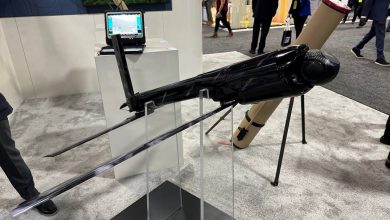What to look out for at Eurosatory, Europe’s biggest defense show

PARIS — Europe’s largest defense show kicks off in Paris on Monday, and this year’s edition of the Eurosatory exhibition will reflect feedback from two years of war in Ukraine, said Charles Beaudouin, the retired major general and former head of the French Army’s equipment office who is running the show in his role as CEO of COGES Events.
The 2024 show takes “the full measure” of the conflict, after a 2022 edition marked by the shock of Russia’s invasion of Ukraine, Beaudouin said in an interview with Defense News. European governments have raised their defense budgets “so the business is there,” and military planners attending the show will be focused on drones, anti-drone systems, air defense, long-range fires and mine clearing.
Exhibition space is fully booked with more than 2,000 exhibitors compared with 1,750 in 2022, and the show is on track for a record number of visitors, with weekly registrations in early June more than 40% above the prior edition, which had around 32,000 unique visitors.
1. Drones
Small unmanned aerial vehicles have become ubiquitous on the Ukrainian battlefield and they’ll be omnipresent at Eurosatory, according to Beaudouin, with the conflict confirming the “supremacy of small drones,” from nano to micro and mini drones. “The small drone remains unstoppable today, making the battlefield transparent.”
Big tactical drones and medium-altitude long-endurance drones such as General Atomics’ Reaper and Safran’s Patroller “have a real problem” in a non-permissive conflict, as they’re easy to spot, slow, not armed for self defense and very expensive, says Beaudouin. Look out at Eurosatory for hardy, expendable tactical drones, as well as stealthy drones that can operate close to the battle.
Reticence around offensive drones has disappeared, from Eurosatory 2018 having no armed drones to around half of the UAVs at the 2022 edition being armed, while for this year’s show “everyone has made the jump to loitering munitions.” Suicide drones had previously been somewhat of a red line for some countries including France, “so it’s the effect of war.”
2. Mobile air defense
Airborne threats on the modern battlefield make troops in the operating theater “extremely vulnerable,” creating a need for systems than can operate alongside troops and provide autonomous air-defense capability in the field at the infantry-section level. The ubiquity of drones means the threat is everywhere, and for the first time since World War II, Western soldiers need to look to the sky.
In addition to specialized ground-air defense systems to cover larger areas, typically expensive and few in number, Beaudouin expects Eurosatory this year to feature air-defense and anti-drone systems that can be mounted on armored personnel carriers and infantry-fighting vehicles, as well as support vehicles to provide troops with close-in air defense.
A solution such as a truck-mounted version of the RapidFire air-defense gun developed by KNDS and Thales may be too expensive for what it does, while laser-based solutions aren’t not yet mature, meaning missiles remain the go-to technology, though that doesn’t rule out new concepts being on show, the general said.
3. Deep fires
With artillery being key on the Ukrainian battlefield, cannons and rocket artillery will be a major topic at Eurosatory 2024, with at least 10 manufacturers showcasing their systems, Beaudouin said. Artillery needs to be long-range, increasingly mobile to deal with the drone threat, and increasingly precise, as illustrated by systems such as the French Caesar howitzer and guided artillery shells such as the U.S.-developed Excalibur and the Katana by KNDS.
The show will feature a M142 HIMARS rocket launcher, and Beaudouin said he’s looking forward to seeing what equivalent solutions will be showcased by European companies including France’s Safran and Thales.
4. Dealing with mines
The war in Ukraine has also put mine clearance back in focus, after European armies had overlooked that capability in the context of a ban on anti-personnel mines and minefields becoming socially less acceptable, according to the Eurosatory boss. While anti-personnel mines are banned at the show, as are cluster munitions, there is “real demand” for capabilities to detect mines and breach minefields.
Beaudouin expects to see mine-clearing solutions at Eurosatory, and will be looking out for technologies such as ground-penetrating radar, as well as more mundane methods such as plows to allow tanks to clear a path through mine fields. He said the problem of both mines and drones is their ubiquity, and armed forces will need solutions at company or infantry-section level to deal with the buried explosive devices.
5. Electronic warfare
With electronic and cyber warfare increasingly part of modern conflict, expect Eurosatory to showcase more systems that are resilient against such attacks, and equipment able to operate in environments where use of global navigation satellite systems (GNSS) is denied.
In the context of the “operational comfort” of the past 30 years, Western armies increasingly switched to satellite-based positioning, navigation and timing, which is cheaper and more precise than using inertial measurement units. With systems increasingly have to be able to work in GNSS-denied conditions, one development to watch is hybrid navigation that couples inertial measurement and GPS, according to Beaudouin.
Communication will have to become more flexible to deal with a contested environment, with “very agile” radios that can switch between low bandwidth and broadband depending on the level of threat and interference. One concept that may appear is a “proximity 4G bubble” to allow broadband communications between an armored infantry vehicle and its dismounted troops, Beaudouin said. The growing amount of data on the battlefield will require channels beyond VHF or UHF, so “broadband is a real issue.”
6. Armor for high-intensity warfare
The asymmetrical conflicts of the post-Cold War period resulted in vehicles that were much higher than the preceding generation of armor, with heavy anti-blast shields to protect against mines and improvised explosive devices. Surviving the battlefield in Ukraine requires a return to more stealthy armor at odds with tall MRAPs, which in addition are unstable due to their high center of gravity, according to Beaudouin.
The Eurosatory boss expects “a step backwards” to lower vehicles, with specialized equipment taking care of mines rather than relying on thick bottom armor for protection, and will be on the lookout to see whether this year’s event confirms that trend. The show will also reflect that heavy armor continues to be relevant, with the French Leclerc and the American M1 Abrams main battle tanks on display.
The future may bring armored vehicles with a lower profile, stealthy materials and reduced thermal and radar signatures, and a focus on protection against drones instead of IEDs, according to Beaudouin. Armor will have to take into account ground-to-air defense, while being stealthier may require the vehicles to be less like “a Christmas tree of tricks” covered in sensors and equipment.
“We’re at the dawn, but only at the dawn, of a new definition of armored vehicles,” Beaudouin said. “War always takes us by surprise, and forces us to adapt.”
Rudy Ruitenberg is a Europe correspondent for Defense News. He started his career at Bloomberg News and has experience reporting on technology, commodity markets and politics.
Read the full article here





